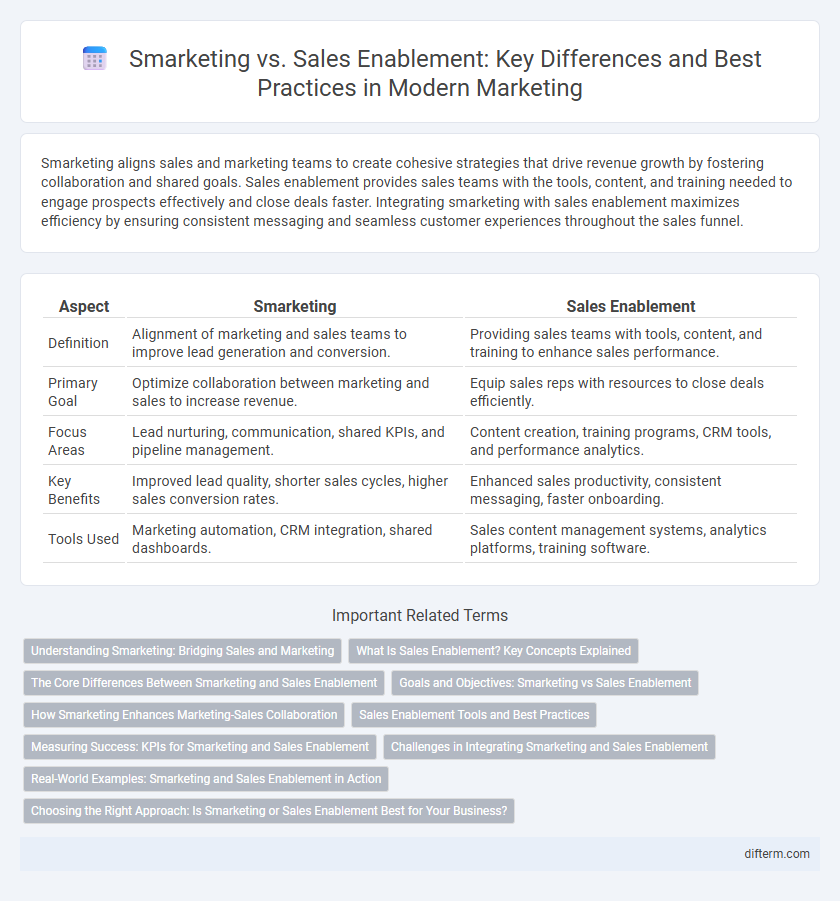Smarketing aligns sales and marketing teams to create cohesive strategies that drive revenue growth by fostering collaboration and shared goals. Sales enablement provides sales teams with the tools, content, and training needed to engage prospects effectively and close deals faster. Integrating smarketing with sales enablement maximizes efficiency by ensuring consistent messaging and seamless customer experiences throughout the sales funnel.
Table of Comparison
| Aspect | Smarketing | Sales Enablement |
|---|---|---|
| Definition | Alignment of marketing and sales teams to improve lead generation and conversion. | Providing sales teams with tools, content, and training to enhance sales performance. |
| Primary Goal | Optimize collaboration between marketing and sales to increase revenue. | Equip sales reps with resources to close deals efficiently. |
| Focus Areas | Lead nurturing, communication, shared KPIs, and pipeline management. | Content creation, training programs, CRM tools, and performance analytics. |
| Key Benefits | Improved lead quality, shorter sales cycles, higher sales conversion rates. | Enhanced sales productivity, consistent messaging, faster onboarding. |
| Tools Used | Marketing automation, CRM integration, shared dashboards. | Sales content management systems, analytics platforms, training software. |
Understanding Smarketing: Bridging Sales and Marketing
Smarketing integrates sales and marketing teams through aligned goals, shared metrics, and transparent communication to enhance overall revenue performance. This collaborative approach ensures marketing campaigns generate high-quality leads that sales can effectively convert, reducing friction and improving conversion rates. By bridging the gap between strategies and execution, smarketing fosters a unified customer journey and accelerates business growth.
What Is Sales Enablement? Key Concepts Explained
Sales enablement involves equipping sales teams with the tools, content, and information necessary to engage buyers effectively and close deals efficiently. This strategic approach integrates training, content management, and customer data analytics to enhance sales productivity and alignment with marketing objectives. Key concepts include onboarding processes, real-time sales coaching, and leveraging CRM systems to deliver personalized buyer experiences.
The Core Differences Between Smarketing and Sales Enablement
Smarketing aligns marketing and sales teams to create a unified strategy that drives revenue growth by sharing goals, metrics, and communication. Sales enablement focuses on equipping sales teams with the tools, content, and training necessary to effectively engage prospects and close deals. The core difference lies in smarketing fostering collaboration across departments, while sales enablement targets empowering sales execution through resources and support.
Goals and Objectives: Smarketing vs Sales Enablement
Smarketing aims to unify marketing and sales teams to drive revenue growth through aligned goals, such as improving lead quality and accelerating the sales cycle. Sales enablement focuses on equipping sales teams with the tools, content, and training needed to effectively engage prospects and close deals. While smarketing prioritizes collaborative strategy and shared KPIs, sales enablement zeroes in on enhancing the sales process and boosting individual rep productivity.
How Smarketing Enhances Marketing-Sales Collaboration
Smarketing enhances marketing-sales collaboration by aligning goals, strategies, and metrics, fostering a unified approach to customer acquisition and retention. This synchronization improves communication, reduces friction, and ensures that both teams share real-time data and insights, resulting in more effective lead nurturing and higher conversion rates. By integrating sales feedback into marketing campaigns, Smarketing drives targeted content creation that addresses specific buyer needs, optimizing the overall sales funnel performance.
Sales Enablement Tools and Best Practices
Sales Enablement tools such as CRM platforms, content management systems, and analytics software streamline the sales process by providing reps with timely, relevant content and data-driven insights. Best practices include continuous training, alignment of marketing and sales teams, and leveraging technology to deliver personalized buyer experiences that drive higher conversion rates. Integrating these tools fosters improved communication, accelerates sales cycles, and enhances overall revenue growth.
Measuring Success: KPIs for Smarketing and Sales Enablement
Measuring success in Smarketing involves tracking KPIs such as lead quality, conversion rates, and alignment between marketing and sales teams to ensure cohesive revenue growth. Sales Enablement success is assessed through metrics like content usage rates, sales cycle length reduction, and win rates, highlighting the effectiveness of tools and training provided to sales representatives. Both disciplines rely on data-driven insights to optimize collaboration and drive consistent business results.
Challenges in Integrating Smarketing and Sales Enablement
Integrating smarketing and sales enablement faces challenges such as misaligned goals between marketing and sales teams, leading to inconsistent messaging and prioritization of leads. Data silos and lack of shared analytics hinder transparency and collaboration, reducing the effectiveness of joint strategies. Overcoming these barriers requires streamlined communication channels and unified performance metrics to synchronize efforts and maximize revenue growth.
Real-World Examples: Smarketing and Sales Enablement in Action
Smarketing integrates marketing and sales teams through shared goals and data-driven processes, as seen in HubSpot's alignment of content creation with sales messaging to boost lead conversion by 20%. Sales Enablement focuses on equipping salespeople with tools, content, and training, exemplified by Salesforce providing reps with personalized analytics dashboards that increased deal closure rates by 15%. Both strategies enhance revenue growth by fostering collaboration and leveraging technology to optimize customer engagement throughout the buyer's journey.
Choosing the Right Approach: Is Smarketing or Sales Enablement Best for Your Business?
Choosing the right approach between Smarketing and Sales Enablement depends on your business goals and team alignment. Smarketing emphasizes the integration and collaboration between sales and marketing teams to create a unified strategy that drives revenue growth. Sales Enablement focuses on equipping sales teams with tools, content, and training to improve effectiveness and close more deals.
Smarketing vs Sales Enablement Infographic

 difterm.com
difterm.com